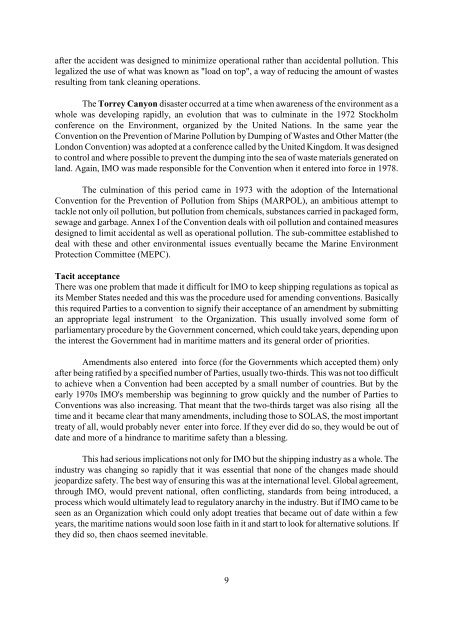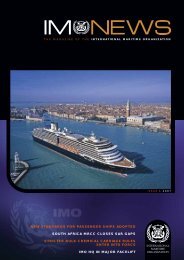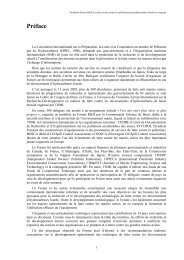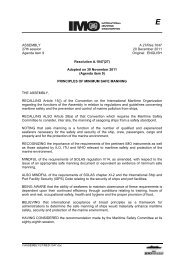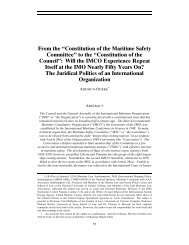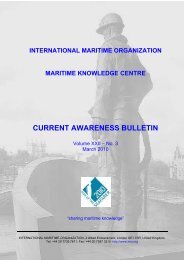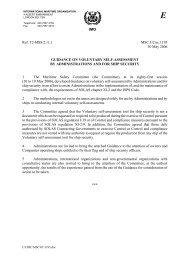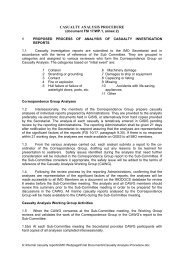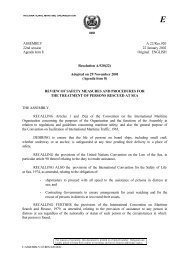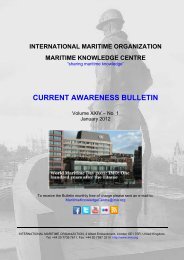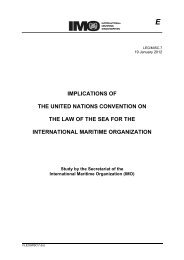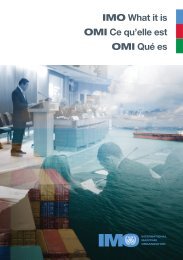wmd 1998 background document.pdf - IMO
wmd 1998 background document.pdf - IMO
wmd 1998 background document.pdf - IMO
Create successful ePaper yourself
Turn your PDF publications into a flip-book with our unique Google optimized e-Paper software.
after the accident was designed to minimize operational rather than accidental pollution. This<br />
legalized the use of what was known as "load on top", a way of reducing the amount of wastes<br />
resulting from tank cleaning operations.<br />
The Torrey Canyon disaster occurred at a time when awareness of the environment as a<br />
whole was developing rapidly, an evolution that was to culminate in the 1972 Stockholm<br />
conference on the Environment, organized by the United Nations. In the same year the<br />
Convention on the Prevention of Marine Pollution by Dumping of Wastes and Other Matter (the<br />
London Convention) was adopted at a conference called by the United Kingdom. It was designed<br />
to control and where possible to prevent the dumping into the sea of waste materials generated on<br />
land. Again, <strong>IMO</strong> was made responsible for the Convention when it entered into force in 1978.<br />
The culmination of this period came in 1973 with the adoption of the International<br />
Convention for the Prevention of Pollution from Ships (MARPOL), an ambitious attempt to<br />
tackle not only oil pollution, but pollution from chemicals, substances carried in packaged form,<br />
sewage and garbage. Annex I of the Convention deals with oil pollution and contained measures<br />
designed to limit accidental as well as operational pollution. The sub-committee established to<br />
deal with these and other environmental issues eventually became the Marine Environment<br />
Protection Committee (MEPC).<br />
Tacit acceptance<br />
There was one problem that made it difficult for <strong>IMO</strong> to keep shipping regulations as topical as<br />
its Member States needed and this was the procedure used for amending conventions. Basically<br />
this required Parties to a convention to signify their acceptance of an amendment by submitting<br />
an appropriate legal instrument to the Organization. This usually involved some form of<br />
parliamentary procedure by the Government concerned, which could take years, depending upon<br />
the interest the Government had in maritime matters and its general order of priorities.<br />
Amendments also entered into force (for the Governments which accepted them) only<br />
after being ratified by a specified number of Parties, usually two-thirds. This was not too difficult<br />
to achieve when a Convention had been accepted by a small number of countries. But by the<br />
early 1970s <strong>IMO</strong>'s membership was beginning to grow quickly and the number of Parties to<br />
Conventions was also increasing. That meant that the two-thirds target was also rising all the<br />
time and it became clear that many amendments, including those to SOLAS, the most important<br />
treaty of all, would probably never enter into force. If they ever did do so, they would be out of<br />
date and more of a hindrance to maritime safety than a blessing.<br />
This had serious implications not only for <strong>IMO</strong> but the shipping industry as a whole. The<br />
industry was changing so rapidly that it was essential that none of the changes made should<br />
jeopardize safety. The best way of ensuring this was at the international level. Global agreement,<br />
through <strong>IMO</strong>, would prevent national, often conflicting, standards from being introduced, a<br />
process which would ultimately lead to regulatory anarchy in the industry. But if <strong>IMO</strong> came to be<br />
seen as an Organization which could only adopt treaties that became out of date within a few<br />
years, the maritime nations would soon lose faith in it and start to look for alternative solutions. If<br />
they did so, then chaos seemed inevitable.<br />
9


